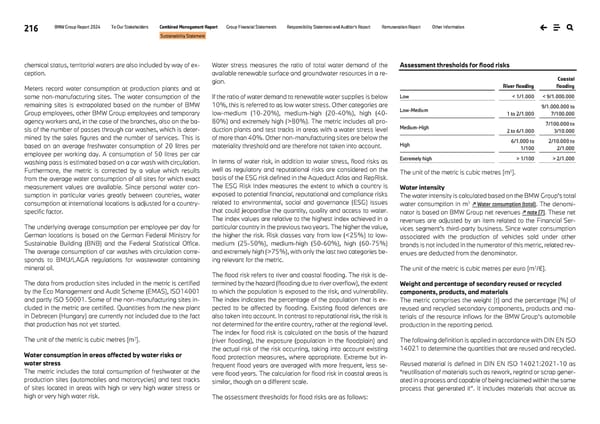216 BMW Group Report 2024 To Our Stakeholders Combined Management Report Group Financial Statements Responsibility Statement and Auditor’s Report Remuneration Report Other Information Sustainability Statement chemical status, territorial waters are also included by way of ex- ception. Meters record water consumption at production plants and at some non-manufacturing sites. The water consumption of the remaining sites is extrapolated based on the number of BMW Group employees, other BMW Group employees and temporary agency workers and, in the case of the branches, also on the ba- sis of the number of passes through car washes, which is deter- mined by the sales figures and the number of services. This is based on an average freshwater consumption of 20 litres per employee per working day. A consumption of 50 litres per car washing pass is estimated based on a car wash with circulation. Furthermore, the metric is corrected by a value which results from the average water consumption of all sites for which exact measurement values are available. Since personal water con- sumption in particular varies greatly between countries, water consumption at international locations is adjusted for a country- specific factor. The underlying average consumption per employee per day for German locations is based on the German Federal Ministry for Sustainable Building (BNB) and the Federal Statistical Office. The average consumption of car washes with circulation corre- sponds to BMU/LAGA regulations for wastewater containing mineral oil. The data from production sites included in the metric is certified by the Eco Management and Audit Scheme (EMAS), ISO14001 and partly ISO 50001. Some of the non-manufacturing sites in- cluded in the metric are certified. Quantities from the new plant in Debrecen (Hungary) are currently not included due to the fact that production has not yet started. The unit of the metric is cubic metres [m3]. Water consumption in areas affected by water risks or water stress The metric includes the total consumption of freshwater at the production sites (automobiles and motorcycles) and test tracks of sites located in areas with high or very high water stress or high or very high water risk. Water stress measures the ratio of total water demand of the available renewable surface and groundwater resources in a re- gion. If the ratio of water demand to renewable water supplies is below 10%, this is referred to as low water stress. Other categories are low-medium (10-20%), medium-high (20-40%), high (40- 80%) and extremely high (>80%). The metric includes all pro- duction plants and test tracks in areas with a water stress level of more than 40%. Other non-manufacturing sites are below the materiality threshold and are therefore not taken into account. In terms of water risk, in addition to water stress, flood risks as well as regulatory and reputational risks are considered on the basis of the ESG risk defined in the Aqueduct Atlas and RepRisk. The ESG Risk Index measures the extent to which a country is exposed to potential financial, reputational and compliance risks related to environmental, social and governance (ESG) issues that could jeopardise the quantity, quality and access to water. The index values are relative to the highest index achieved in a particular country in the previous two years. The higher the value, the higher the risk. Risk classes vary from low (75%), with only the last two categories be- ing relevant for the metric. The flood risk refers to river and coastal flooding. The risk is de- termined by the hazard (flooding due to river overflow), the extent to which the population is exposed to the risk, and vulnerability. The index indicates the percentage of the population that is ex- pected to be affected by flooding. Existing flood defences are also taken into account. In contrast to reputational risk, the risk is not determined for the entire country, rather at the regional level. The index for flood risk is calculated on the basis of the hazard (river flooding), the exposure (population in the floodplain) and the actual risk of the risk occurring, taking into account existing flood protection measures, where appropriate. Extreme but in- frequent flood years are averaged with more frequent, less se- vere flood years. The calculation for flood risk in coastal areas is similar, though on a different scale. The assessment thresholds for flood risks are as follows: Assessment thresholds for flood risks River flooding Coastal flooding Low < 1/1.000 < 9/1.000.000 Low-Medium 1 to 2/1.000 9/1.000.000 to 7/100.000 Medium-High 2 to 6/1.000 7/100.000 to 3/10.000 High 6/1.000 to 1/100 2/10.000 to 2/1.000 Extremely high > 1/100 > 2/1.000 The unit of the metric is cubic metres [m3]. Water intensity The water intensity is calculated based on the BMW Group's total water consumption in m3 ↗ Water consumption (total). The denomi- nator is based on BMW Group net revenues ↗ note [7]. These net revenues are adjusted by an item related to the Financial Ser- vices segment's third-party business. Since water consumption associated with the production of vehicles sold under other brands is not included in the numerator of this metric, related rev- enues are deducted from the denominator. The unit of the metric is cubic metres per euro [m3/€]. Weight and percentage of secondary reused or recycled components, products, and materials The metric comprises the weight [t] and the percentage [%] of reused and recycled secondary components, products and ma- terials of the resource inflows for the BMW Group’s automobile production in the reporting period. The following definition is applied in accordance with DIN EN ISO 14021 to determine the quantities that are reused and recycled. Reused material is defined in DIN EN ISO 14021:2021-10 as “reutilisation of materials such as rework, regrind or scrap gener- ated in a process and capable of being reclaimed within the same process that generated it”. It includes materials that accrue as
 BMW Group Report 2024 Page 215 Page 217
BMW Group Report 2024 Page 215 Page 217